

In terms of relevance, the article could be useful to people concerned with career development, leadership, and management. The author does not directly impose solutions but rather seeks to appeal to the reader who can potentially be faced with a similar dilemma. His voice appeals to even the most reserved people by inspiring them to reassess their own beliefs and opinions on the issue. It is easy for most people to relate to Tobak’s (2014) article. It is adequately informative because it cites practical examples that most people know of as a justification for the view that Armstrong should in fact be accorded some leniency and respect. Its effectiveness arises from the persuasive manner in which it suggest solutions to ethical dilemmas similar to the one Armstrong encountered. This informative article is informative because it draws comparison between Armstrong’s unethical actions and the daily circumstances of today’s business executives. It explains that Armstrong should not be automatically dismissed as irredeemably unethical (Tobak, 2014). This article draws attention to the fact that most people have used unethical means even at the most minimal level to gain advantage. Unfortunately, his success was short-lived. Like business leaders, Armstrong was highly motivated to become successful in his sport and hence opted to look for performance enhancing options.

Therefore, in Tobak’s (2014) view, these situations are comparable to Armstrong’s story. If these risks initially pay off and the individuals makes progress, then they build the success on that foundation only for their inconsistencies to catch up with them later (Bailey, 2008).

The article goes on to explain that most people do not have bad intentions but take big risks especially when they are young and desperate for success. Other scandals, such as stock option backdating in high-technology sectors are also explained in the article. There are many instances of executives telling lies in their resumes earlier on in their careers only to be caught later after great advancement, like Yahoo’s Scott Thompson who faced a resume-gate scandal. Tobak (2014) explains that most people building their careers take huge risks. He demonstrated the same qualities that define the corporate world. Tobak (2014) suggests that Armstrong’s circumstances reflect day-to-day business realities. People fighting to climb up in the business world exhibit competitiveness, great drive, and are willing to do almost anything to move forward. This article compares Lance Armstrong’s situation to that of stakeholders in the business and corporate world. Lance came into the spotlight following a doping scandal that he was investigated for and after which he eventually admitted to doping during a popular American reality television show.
#STEVE TOBAK INVISOR CONSULTING PROFESSIONAL#
Armstrong rose to fame initially as a triathlete early in his life before proceeding to the status of a professional road racing cyclist. This article by Steve Tobak, a management consultant and executive coach with Invisor Consulting focuses on former cyclist Lance Armstrong. Is it informative? Persuasive? Ineffective? Who might find it useful? Can you tell what type of audience for which the article is intended (one hint for this-in what type of magazine/journal did it appear?)? Do you agree or disagree with the author’s points why or why not? To what extent? This is graded according to the Abstract and Evaluation Rubric.Ībstract and Evaluation of Steve Tobak’s “ Lessons Can Be Learned from Athletes’ Mistakes’” ORDER ABSTRACT NOW Then, on a separate paragraph, evaluate the article in 275 words. In lieu of a title, put the APA article citation at the top of the page. You will write a 275-word abstract of either “Lessons Can Be Learned from Athletes’ Mistakes” (Article is attached).


 0 kommentar(er)
0 kommentar(er)
